![]()
![]()
![]()
Use LEFT and RIGHT arrow keys to navigate between flashcards;
Use UP and DOWN arrow keys to flip the card;
H to show hint;
A reads text to speech;
173 Cards in this Set
- Front
- Back
|
Chi Rho
|
the p/x symbol seen by Constantine in a vision the night before he battled Maxentius, represents Christ, opens Constantine to the idea of Christianity
|
|
|
Edict of Milan
|
Constantine legalizes Christianity
|
|
|
Constantine
|
Boy, how's this for a broad topic...uhm, he ended the short-lived tetrarchy, legalized Christianity, bridged the gap between Roman and Early Christian art, etc...
|
|
|
Helena
|
Constantine's mom, gathered relics like the True Cross
|
|
|
Sol Invictus
|
unconquered Roman sun god, has rays coming out of his head that inspired the halo
|
|
|
Dura Europas
|
on the Euphrates river, site abandoned in 3rd century AD, buried by sand
|
|
|
The Christian House Church
|
a community home, baptistery, school rooms, replacement for organized churches
image of Christ as the Good Shepherd, baptism into the fold at Dura Europas |
|
|
catacombs
|
underground burial for Christians in the area immediately surrounding Rome
decorated to look like an interior depictions of the Resurrection and types thereof |
|
|
Jonah Cycle
|
catacomb art
Jonah=resurrection |
|
|
Christian Mosaics
|
in mausoleums and basilicas, depictions of Christ and gospel stories
wall decoration as opposed to floor like the Romans |
|
|
basilica plan church
|
longitudinal, Latin cross, St Peter's Basilica, nave, apse, etc
|
|
|
central plan church
|
x with dome
|
|
|
Greek cross
|
equally long arms
basis of central plan church |
|
|
Latin cross
|
one longer arm of cross
basis of basilica |
|
|
tholos
|
small round building, often used as a tomb
|
|
|
narthex
|
porch area of a basilica/cathedral
|
|
|
nave
|
large central area of a basilica
|
|
|
aisles
|
on either side of the nave, separated by columns
|
|
|
apse
|
semi-circular area at the end of a basilica, altar, judgment
|
|
|
altar
|
found in the apse, end of the symbolic journey
|
|
|
transept
|
section running perpendicular to nave in a basilica
|
|
|
clerestory
|
high windows in the nave
|
|
|
Ravenna
|
center of the Early Christian church, a lot of architecture with mosaics and such
|
|
|
syncretization
|
combining/appropriating old ideas with new ones after merging two cultures
|
|
|
Julian the Apostate
|
a Pagan holdover, attempted to outlaw Christianity
|
|
|
rotunda
|
circular ground plan covered by a dome
|
|
|
liturgy
|
customary public worship done by a religious group
|
|
|
Eucharist
|
Last Supper, Holy Sacrament
|
|
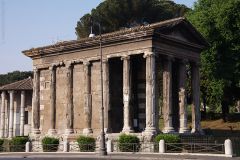
|
Roman Republic
Temple of Portunus |
|
|
How does the Temple of Portunus exemplify the appropriation of Etruscan and Greek styles?
|
Etruscan:
-Single staircase -Podium -closed cella Greek: -peripteral colonnade -one cella, not three |
|

|
Roman Republic
Head of a Roman Patrician |
|
|
Ideals of the Roman Republic
|
-Verism, truth
-Honor -Sacrifice -Please the gods -Devotion to country, civic duty Exemplified in: Temples, portrait busts |
|
|
First Pompeian Style
|
Incrustation
trying to replicate stone the facade! |
|
|
Second Pompeian Style
|
Archetectonic
expands space depth, landscape, architecture perspective, vanishing point depictions of nature |
|
|
Third Pompeian Style
|
Ornamental
Smaller, delicate forms, decorative, no need to hold weight pure, purely decorative |
|
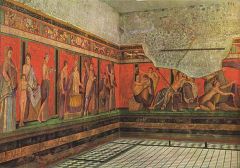
|
Roman Republic
Villa of Mysteries |
|
|
Dynamic Functionalism
|
man can conquer nature
skill and precision Ex: aqueducts |
|
|
Innovations of Roman architecture
|
arches, domes, concrete, aqueducts, vaults (barrel and groin)
Be prepared to identify where it was used and why |
|
|
True art of the Romans
|
From Virgil:
military, government |
|
|
Atrium
|
fountain, open area, entrance to villa
|
|
|
cubiculum
|
bedroom, small, simple
|
|
|
peristyle
|
peripteral colonnade, enclosed garden area for contemplation
|
|
|
Triclinium
|
three benches, room for entertaining
|
|
|
Message and aims of Imperial art and architecture
|
everything revolves around the Emperor
Emphasize the power of the empire and the Emperor |
|
|
Ara Pacis as propaganda
|
divine origins
figures and flora Romulus and Remus Aeneas Procession on either side: story 1+story 2=story 3 children as future compare to processional frieze in Parthenon Rome Tellus: fertility, heavens, seas everything's better with Augustus! :) |
|
|
Prima Porta Augustus as propaganda
|
spear=allusion to Spear Bearer, Augustus as embodiment of perfection
extended arm=addressing the troops, hearkens back to L'Arringatore, adlocutio general's swag, drapery great detail: every thread carved breastplate: divine origins all gods present Tellus w/ Romulus and Remus Cupid and the dolphin, Venus: divine ancestry barefoot=apotheosis |
|
|
Imperial Portraiture:
Augustus |
Idealized but still individual
Youth and power |
|
|
Imperial Portraiture:
Vespasian |
smiling, aged, wrinkled, very round face
emphasis on wisdom and age and experience |
|
|
Imperial Portraiture:
Caracalla |
creepy scary, Mr. Angry Eyes
x on face from brow to mouth stipply beard and mustache, mini fro |
|
|
Imperial Portraiture:
Philip the Arab |
x on face, Pathetic Style, not anger-face
shows his Syrian ethnicity |
|
|
Imperial Portraiture:
Trebonianus Gallus |
tiny head, emphasis on physical strength
all bronze:) I mean brawn |
|
|
Imperial Portraiture:
Marcus Aurelius |
Equestrian Statue
full army regalia preserved b/c they thought it was Constantine domination over powerful horse horse analogy of Rome orb=full domain, all of everywhere covered in gold addressing the troops, reaching out |
|
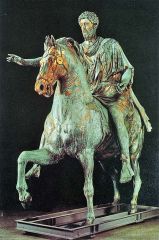
|
Roman Empire
Equestrian Statue of Marcus Aurelius |
|
|
Imperial Portraiture:
Commodus |
Portrayed as Hercules, equated himself with a demi-god. What a tool. Skin of Nemean Lion, club, apples of Hersperides
Changed Rome to Colony of Commodus. He just oozes tooliness still looks like his father Marcus Aurelius with the hair and beard and droopy eyes |
|
|
Constantine and Early Christian Art
|
legalized Christianity
Basilica Nova influenced Christian basilicas |
|
|
origins of the basilica
|
Basilica Nova (of Maxentius or Constantine)
based on the Latin cross |
|
|
origins of central plan church
|
Greek cross
|
|
|
Use and iconography of the Christian catacombs
|
Catacombs: used for burial
many depictions of Christ as the Good Shepherd, the desire to be gathered into His fold after death resurrection and rebirth: Jonah, Lazarus, woman being healed by touching the hem of Christ's robe Adam and Eve: Adam brought death into the world |
|
|
Use and iconography of paintings and mosaics
|
depictions of choices
Paring of Lot and Abraham: Lot to Sodom (depicted as a Roman city, Abraham to Promised Land |
|
|
Paganism vs Christianity on the Sarcophagus of Junius Bassus
|
reformed Pagan
Sacrifice of Isaac + Job on the Dung Heap: Suffering of Christians Paul in Prison + Adam and Eve Christ Enthroned (w/ Peter and Paul) + Christ Entering Jerusalem: a kind of equestrian portrait, looks like Apollo, an emperor Roman sun god as footstool Christ before Pilate + Daniel and the Lion's Den, Paul's execution: neither denied the faith, ruler could not release from fate |
|
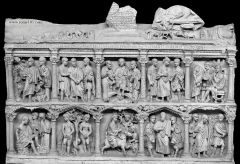
|
Early Christian Art
Sarcophagus of Junius Bassus |
|
|
Pagan Holdovers
|
Symmachi Diptych:
Union of two wealthy Pagan families Purely Pagan in look, style, theme, and content Classical proportion and drapery portrays Pagan worship Julian the Apostate attempted to outlaw Christianity |
|
|
Who was Julian the Apostate?
|
Pagan holdover, attempted to outlaw Christianity
|
|
|
phalanx
|
foot soldiers with SUPER long pikes, stood in rows and rows with those crazy pikes
|
|
|
The Greek Tragedy
|
very Hellenistic in nature
dramatic, emotional, theatrical (duh) |
|
|
orchestra
|
the stage of a Greek theatre
|
|
|
proscenium
|
the curtain area of a Greek stage, separated the skene from the orchestra
|
|
|
skene
|
backstage area of a Greek theatre
|
|
|
Pergamum
|
location of the Great Altar of Pergamum, sourse of "Athena Attacking the Giants"
|
|
|
Gaul
|
enemies of the Greeks
mustaches and leather cord necklaces ex: The Dying Gaul |
|
|
Phillip II of Macedonia
|
What?!
Oh. Father of Alexander the Great |
|
|
Alexander the Great
|
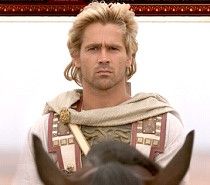
mmm:) What a freakin stud!
tutored by Aristotle conquered the known world by 25. He's no Moroni, but DANG. Founded Alexandria Died at 31, divided the empire into 3 |
|
|
Apelles
|
A Greek painter who painted a portrait of Alexander the Great.
What a lucky man. |
|
|
Ptolemy
|
Mathematician, astronomer, etc.
Nerd. |
|
|
Halicarnassus
|
A key battle site between Alexander the Great (yay!) and the Persians (boo...)
say it with a Mater accent...Hally CAAARRRRR nassus. Whee dawggeh. |
|
|
Transition from Classical to Late Classical
|
Late Classical: dealt more with mortals and not just gods, extends into viewers space, taller and slimmer (1:8)
ex: Apoxyomenos, or The Scraper |
|
|
Transition from Late Classical to Hella-Nistic (shoot, dats HELLA nistic. Look at dat nisticism)
|
Think extremes! (Thank you review sheet)
individual, specific, mortals, emotion, melodramatic wider range of patrons |
|
|
Etruscan Temple of Veii
Comparisons to Greek |
Tuscan columns (aka Doric with a base), terra-cotta-coated wood, no peripteral colonnade
sculpture on the roof, not in the pediment (open), eaves hang over the sides 3 cella, all enclosed, not just one open one |
|
|
Early Etruscan Funerary Art vs Late Etruscan Funerary Art
|
Early: Reclining Couple
Feasting with his wife for eternity:) women could have property, social standing gesturing with an egg=resurrection terra-cotta lifelike quality-->the viewers matter awkward position and proportion; meaning>appearance Late: Lars Pulena alone, grumpy sides portray achievements bludgeoned to death by vamps |
|
|
Etruscan tomb decoration
|
made to look like an interior
superfluous columns carvings of any sort of anything you could need in the next life Cerberus, Dolphins Pillows for the dead! Cute no care for proportion, anatomical correctness |
|
|
repoussé
|
forms hammered out from behind
ex: the lions on the gold fibula (toga) incidentally...lions were an ancient near eastern influence |
|
|
granulation
|
Tiny tiny dots added as detail. Tiny.
ex: fibula (gold toga pin) |
|
|
filigree
|
tubular lines
ex: the woven band lookin things on the fibula (toga pin) |
|
|
Divination
|
telling the future from earthly objects
ex: the Etruscan Piaczenza Bronze Liver. I miss Italian.Cz? Legit. |
|
|
Etruria
|
home of the Etruscans, region in northern Italy
natural competitors with Rome geographically resources, trade |
|
|
Rasenna
|
What the Etruscans called themselves...
But...why did we come up with something new...? I'm a lil bit weirded out |
|
|
Necropolis
|
Etruscan style city of the dead
interiors made to look like a home |
|
|
Tumulus tombs
|
mounds of earth used for burial..I dunno, Juliette...I'd check Wikipedia =/
|
|
|
Vanth
|
Etruscan mythological figure
female demon |
|
|
Haruspex
|
an Etruscan man trained in divination.
Where's Emma Thompson when you need her? |
|
|
wattle and daub
|
wooden strips called wattle is daubed with a goopy goo made of soil, poo, clay, sand, and straw
|
|
|
podium
|
used as the base of Etruscan temples and later Roman temples, unlike the Greeks
|
|
|
Tuscan order
|
similar to the Doric order but there was a base and an unfluted shaft
used in Etruscan architecture |
|
|
Veii
|
the most important city in Etruria
|
|
|
Rome
|
Um...I want to go to there.
This is fo shiz one of our terms. What are we supposed to put here? |
|
|
Romulus
|
Twin brother of Remus, who he killed.
Founder of Rome |
|
|
The Roman Forum and the Sacred Way
|
The center of Ancient Rome
|
|
|
plebs and patricians
|
Roman commoners and nobility
|
|
|
barrel vault
|
similar to a round arch but with added buttressing
|
|
|
groin vault
|
two intersecting perpendicular barrel vaults
|
|
|
Fasces
|
bundle of sticks, symbol of power through unity
|
|
|
lictor
|
basically a body guard
carried a fasces |
|
|
republic
|
rule of many
|
|
|
oligarchy
|
rule of the few
reliant on public servitude to exist |
|
|
toga
|
worn only by Roman citizens
|
|
|
consul
|
two of these ruled Rome at a time per year and were the heads of the Republic
|
|
|
triumvirate
|
three equal rulers during the Roman Republic
|
|
|
Battle of Actium
|
Octavian and his forces against those of Cleopatra and Ptolemaic Egypt
Octavian won, thus consolidating the power of Rome and becoming the first Emperor, Augustus. |
|
|
verism
|
recreation of the real, attempting to capture the personality and character of a subject, ie. portrait busts
|
|
|
keystone and voussoirs
|
wedge-shaped stones, part of an arch
|
|
|
annular vault
|
same as a barrel vault, says Wikipedia.
|
|
|
engaged comlumns
|
semi-circle columns protruding from a wall, like the walls of a Roman temple perhaps?
|
|
|
exedrae
|
semi-circular recess often covered by a dome
developed into the apse used in Nero's palace and gymnasiums |
|
|
concrete and its parts
|
quicklime, pumice aggregate, ash
an architectural innovation of the Romans, ie. dome of the Pantheon |
|
|
mosaic
|
tesserae!
used for floors in Roman buildings like baths and stuff |
|
|
Sulla
|
Dictator during the Roman Republic
|
|
|
Pompeii
|
ancient Roman vacation spot, destroyed by lava in the eruption of Mt Vesuvius
|
|
|
Julius Caesar
|
great-uncle to Octavius/Augustus
Consul/dictator of the Roman Republic, instrumental in moving Rome from Republic to Empire |
|
|
Octavian
|
One of the many names of emperor Augustus, first of the Roman Emperors
adopted great-nephew of Julius Caesar |
|
|
Pax Romana
|
200 year span of relative peace and minimal expansion in the Roman Empire
|
|
|
Pontifex Maximus
|
A high priest in Roman religion
With Augustus, this became part of the role of Emperor |
|
|
Vitruvius
|
engineer
wrote about the Etruscan Temple at Veii maybe associated with aqueducts? Vitruvian Man by Da Vinci is based on his writings |
|
|
Marcus Agrippa
|
Roman general
won the Battle of Actium against Marc Anthony and Cleopatra |
|
|
Tellus
|
Roman Earth goddess
|
|
|
cameo
|
exemplified by the Gemma Augustea
carving in stone down to the second layer to reveal the color |
|
|
Nero
|
always personified with a huge neck and way fat
Just a real tool and a half |
|
|
The Golden House
|
of Nero
in the center of Rome pleasure lake, Colossus statue, Laocoon statue, dining area, use of cement |
|
|
Pompey
|
part of the first triumvirate in the Roman Republic
|
|
|
Titus
|
sacked Jerusalem
|
|
|
Bath Architecture
|
frigidarium --> tepidarium --> caldarium
business, worship, pleasure |
|
|
Septimius Severus
|
portrait bust meant to look like Marcus Aurelius
not a native Roman Father of Caracalla |
|

|
Late Classical Greek
Hermes and the Infant Dionysus [Praxiteles] |
|
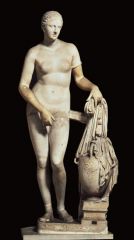
|
Late Classical Greece
Aphrodite of Cnidos [Praxiteles] |
|
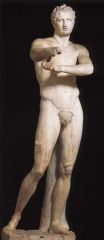
|
Late Classical Greece
Apoxyomenos (the Scraper) [Lyssipos] |
|

|
Late Classical Greece
Alexander the Great [Lyssipos] |
|

|
Hellenistic Greece
Theater at Epidauros [Polykleitos the Younger] |
|
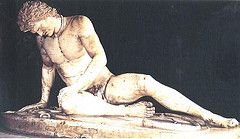
|
Hellenistic Greek
Dying Gaul [Epigonos] |
|
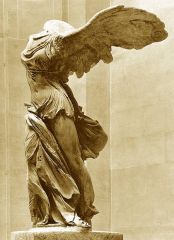
|
Hellenistic Greek
Nike of Samothrace |
|
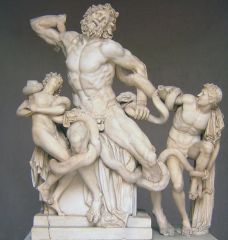
|
Hella-NISTIC Greek
Laocoon and His Two Sons [Polydoros] |
|

|
Etruscan
Fibula |
|

|
Etruscan
Temple at Veii |
|

|
Etruscan
Apollo of Veii |
|
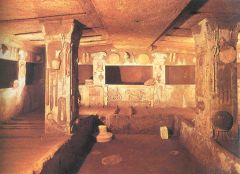
|
Etruscan
Tomb of the Reliefs |
|
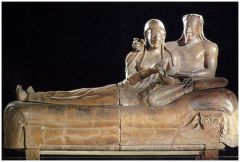
|
Etruscan
Sarcophagus with reclining figures |
|
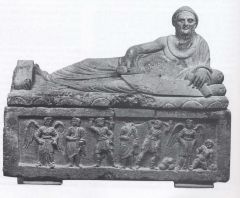
|
Etruscan
Sarcophagus if Lars Pulena |
|
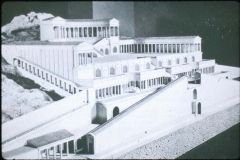
|
Roman Republic
Sanctuary of Fortuna Primigenia |
|
|
Ara Pacis Augustea
|
Roman Empire
|
|
|
Prima Porta Augustus
|
Roman Empire
|
|
|
Coliseum/Flavian Amphitheater
|
Roman Empire
|
|
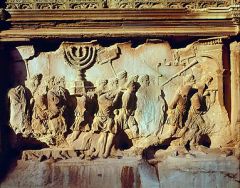
|
Roman Empire
Displaying Spoils, Arch of Titus |
|
|
Bust of a Flavian Woman
|
Roman Empire
|
|
|
The Pantheon
|
Roman Empire
|
|
|
Column of Trajan
|
Roman Empire
|
|
|
Commodus as Hercules
|
Roman Empire
|
|
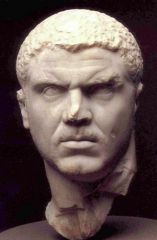
|
Roman Empire
Portrait Bust of Caracalla |
|
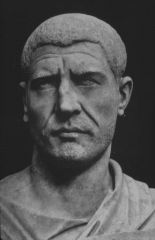
|
Roman Empire
Philip the Arab |
|
|
portraits of the Four Tetrarchs
|
Roman Empire
|
|
|
Arch of Constantine
|
Roman Empire
recycled works from arches of Trajan, Hadrian, and Marcus Aurelius Stole from others to sidestep decline of form places his head over others' |
|
|
Colossal Portrait of Constantine
|
Roman Empire
|
|
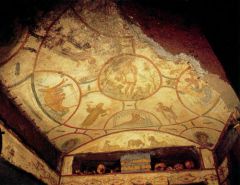
|
Early Christian
The Good Shepherd, Orants, and Jonah Cycle |
|
|
Parting of Lot and Abraham
|
Early Christian
|
|
|
Christ as Good Shepherd
|
mosaic, Early Christian
|
|
|
Symmachi Diptych
|
Pagan in an Early Christian world
|
|
|
Hadrian and his villa
|
subterranean servant tunnels
collected Greek works arches + post and lintel moat, large wall, etc |
|
|
Herculaneum
|
site covered in volcanic ash at the eruption of Mt Vesuvius
preserved architecture, frescoes, skeletons |
|
|
battle of the mulvian bridge
|
where Constantine defeated Maxentius
|
|
|
Trajan
|
Built the Roman Forum
|
|
|
Dacia
|
ancient Eastern European region conquered by Trajan
|
|
|
Nerva
|
first of the Five Good Emperors, followed by Trajan, Hadrian, Antoninus Pius, and Marcus Aurelius
|
|
|
Diocletian
|
began the Tetrarchy
|
|
|
Who began the Tetrarchy?
|
Diocletian
|
|
|
What are the basic artistic and architectural elements of the Coliseum?
|
concrete
tuscan columns Ionic Corinthian vaulting and arches 2 amphitheaters put together retractable roof |
|
|
What is the message of the Coliseum to the public?
|
Hey citizens, let us take this day to celebrate! I'm not a tooly emperor like Nero. Look, I drained his lake to make room for all of this instead of building something for myself!
|

